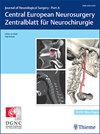Primary extracerebral meningeal glioblastoma: clinical and pathological analysis.
Central European Neurosurgery
Pub Date : 2010-02-01
Epub Date: 2010-02-19
DOI:10.1055/s-0029-1225652
引用次数: 7
Abstract
Primary meningeal gliomas are uncommon tumors in the subarachnoid space, their primary characteristic being the absence of any obvious connection to the brain parenchyma. Rarely, they are quite malignant and assume a bulky, well circumscribed appearance rendering the differential diagnosis from other CNS neoplasms difficult. A 53-year-old man presented with a history of persistent headaches and left sided weakness. Magnetic resonance imaging revealed a temporoparietal mass attached to the dura that strongly resembled a meningioma. At surgery, the outer layer of the dura mater was intact and there was a clear brain-tumor interface without obvious pial disruption. Histological examination showed a biphasic pattern consisting of benign connective tissue intermingled with bundles of what seemed to be a glioblastoma. The mass demonstrated strong positivity for GFAP and the MIB labeling index focally exceeded 20%. The tumor was identified as a primary meningeal glioblastoma. The patient was disease-free for 42 months, after which he developed a recurrence for which he was re-operated. This time, the pathological findings of the tumor were those of a typical glioblastoma multiforme. We discuss the origin of the initial neoplasm and also the differential diagnosis that needs to include meningioma, aggressive glioblastoma infiltrating the dura and a recently recognized bimorphic CNS tumor: the desmoplastic glioblastoma.原发性脑外脑膜胶质母细胞瘤:临床与病理分析。
原发性脑膜胶质瘤是发生在蛛网膜下腔的罕见肿瘤,其主要特征是与脑实质无明显联系。罕见的是,它们是恶性的,呈体积大,界限分明的外观,使得与其他中枢神经系统肿瘤的鉴别诊断变得困难。男,53岁,有持续性头痛和左侧无力病史。磁共振成像显示一个附着在硬脑膜上的颞顶肿块,非常类似脑膜瘤。手术时,硬脑膜外层完整,脑瘤界面清晰,脑脊膜无明显断裂。组织学检查显示良性结缔组织与看似胶质母细胞瘤的束相混合的双相模式。质量对GFAP表现出强烈的阳性反应,MIB标记指数局部超过20%。肿瘤被确定为原发性脑膜胶质母细胞瘤。患者无病42个月,之后复发,再次手术。这一次,肿瘤的病理表现是典型的多形性胶质母细胞瘤。我们讨论了最初肿瘤的起源和鉴别诊断,需要包括脑膜瘤,浸润硬脑膜的侵袭性胶质母细胞瘤和最近发现的双形态中枢神经系统肿瘤:结缔组织增生胶质母细胞瘤。
本文章由计算机程序翻译,如有差异,请以英文原文为准。
求助全文
约1分钟内获得全文
求助全文

 求助内容:
求助内容: 应助结果提醒方式:
应助结果提醒方式:


